SCHC over LoRaWAN Efficiency: Evaluation and Experimental Performance of Packet Fragmentation
Abstract
:1. Introduction
2. Related Works
3. SCHC over LoRaWAN
3.1. Brief Introduction to SCHC
3.2. SCHC Fragmentation Concepts
- SCHC Fragment: message sent from the transmitter to the receiver. It transports several tiles. There are two types of messages in this category:
- –
- SCHC Regular Fragments: are generally used to carry tiles that are not the last one of a SCHC Packet;
- –
- All-1 SCHC Fragments: are used to carry the last tile of the SCHC Packet;
- SCHC ACK: message sent from the receiver to the transmitter. It is used to confirm or not confirm the reception of one or more tiles;
- SCHC ACK REQ: message sent from the transmitter to the receiver requesting the confirmation of one or more tiles through a SCHC ACK;
- SCHC Sender-Abort: message sent from the transmitter to the receiver indicating that the transmitter has canceled the transmission of fragments;
- SCHC Receiver-Abort: message sent from the receiver to the transmitter indicating to cancel the transmission of fragments.
- Rule ID: This field is present in all messages and is used to identify whether or not a message is a SCHC Fragment;
- Datagram Tag (DTag): This field uniquely identifies two fragments that belong to two different SCHC Packets. It has a length of T bits;
- W: When the transmitted SCHC Fragments are grouped into windows, this field carries the number of the window to which the fragment belongs. It has a length of M bits;
- Fragment Compressed Number (FCN): This field indicates the sequence number of the tiles. It has a length of N bits;
- Reassembly Check Sequence (RCS): This field only appears in All-1 SCHC Fragment messages. It transports the error detection code based on the CRC32 polynomial. It has a length of U bits;
- C (Integrity Check): This field is 1 bit in size and is used in the SCHC ACK message to report the integrity check of the reassembled SCHC Packet. A value of 1 indicates that the integrity check was performed and was successful. A value of 0 indicates that the integrity check was not performed or that it was an error;
- Compressed Bitmap: This field appears in the SCHC ACK message to report on the receiver bitmap. The bitmap indicates which tiles were received correctly and which were not.
3.3. SCHC Fragmentation over LoRaWAN
4. Modeling Channel Occupation Using SCHC
4.1. Channel Occupancy Efficiency Estimate
4.2. LoRa Frame Time Calculation
4.3. Theoretical Model
- The transmission of a SCHC Packet comprises a transmission window and r retransmission windows of the lost Regular SCHC Fragments;
- For the transmission of all of the SCHC Fragments belonging to a single IPv6 packet, the LoRa spreading factor is the same for all Regular SCHC Fragments;
- For simplicity, all Regular SCHC Fragments have the same number of tiles;
- All messages in the downlink are received by the end device in the first LoRa reception window, that is, at the end of the timer or timer [12]. In this way, the node works in Class A, which is the most restrictive mode of operation;
- The processing of an All-1 SCHC Fragment at the receiver takes longer than the maximum length of the receive windows on the end device. For this reason the node waits for the next message in the uplink to open the window again and thus receive the SCHC ACK message sent in response to an All-1 SCHC Fragment (see Figure 5);
- Our implementation uses a Regular SCHC Fragment to transport the last tile. When one of the Regular SCHC Fragments is lost, the receiver must send a SCHC ACK message to the sender indicating which tiles arrived correctly and which did not. The SCHC ACK message only reports the receipt of tiles belonging to a window. The standard recommends that the SCHC receiver sends a SCHC ACK after every window, even if there is no missing tile. The SCHC sender waits for the SCHC ACK from the SCHC receiver before sending tiles from the next window. If the SCHC ACK is not received, the transmitter sends a SCHC ACK REQ message that can be retransmitted up to seven times.
4.3.1. Block 1
- is the time it takes to transmit a Regular SCHC Fragment message over the wireless medium. Its calculation is explained in Section 4.2;
- n is the amount of Regular SCHC Fragments that must be sent to transmit all tiles within a transmission window. Remember that the model considers one transmission window and several retransmission windows;
- is the time that elapses between the end of a transmission on the uplink and the end of the timer defined in [12];
- is the time that elapses between the end of a transmission on the uplink and the end of the timer defined in [12]. It corresponds to the sum between and ;
- is the time to transmit a SCHC ACK REQ. Its calculation is explained in Section 4.2;
- is the processing time of the SCHC ACK Packet.
4.3.2. Block 2
5. Testbed
- CPU: Xtensa™dual – core 32 – bit LX6 microprocessor (s), up to 600 DMIPS;
- Memory: RAM: 520KB + 4MB and External flash: 8MB;
- WiFi: 802.11b/g/n 16mbps;
- RTC: Running at 150kHz;
- Security: SSL/TLS and WPA Enterprise security support;
- Hash/encryption: SHA, MD5, DES, AES.
6. Results
6.1. Maximizing Efficiency
6.2. Results with and without Processing Times
7. Discussion
8. Conclusions
9. Future Works
Author Contributions
Funding
Informed Consent Statement
Data Availability Statement
Conflicts of Interest
References
- Minaburo, A.; Toutain, L.; Gomez, C.; Barthel, D.; Zúñiga, J.C. SCHC: Generic Framework for Static Context Header Compression and Fragmentation. RFC 8724 2020, 1–71. [Google Scholar] [CrossRef]
- Gimenez, O.; Petrov, I. Static Context Header Compression and Fragmentation (SCHC) over LoRaWAN. RFC 9011 2021, 1–26. [Google Scholar] [CrossRef]
- Platis, A. Performance Evaluation of IPv6 over Sigfox: Focusing on SCHC Fragmentation. Master’s Thesis, Universitat Politècnica de Catalunya, Barcelona, Spain, 2021. [Google Scholar]
- Aguilar, S.; La-Torre, D.S.W.; Platis, A.; Vidal, R.; Gomez, C.; Céspedes, S.; Zúñiga, J.C. Packet Fragmentation over Sigfox: Implementation and Performance Evaluation of SCHC ACK-on-Error. IEEE Internet Things J. 2021; in press. [Google Scholar] [CrossRef]
- Sanchez-Gomez, J.; Gallego-Madrid, J.; Sanchez-Iborra, R.; Santa, J.; Skarmeta, A.F. Impact of SCHC Compression and Fragmentation in LPWAN: A Case Study with LoRaWAN. Sensors 2020, 20, 280. [Google Scholar] [CrossRef] [PubMed] [Green Version]
- Aguilar, S.; Maillé, P.; Toutain, L.; Gomez, C.; Vidal, R.; Montavont, N.; Papadopoulos, G.Z. Performance Analysis and Optimal Tuning of IETF LPWAN SCHC ACK-on-Error Mode. IEEE Sens. J. 2020, 20, 14534–14547. [Google Scholar] [CrossRef]
- Aguilar, S.; Marquet, A.; Toutain, L.; Gomez, C.; Vidal Ferré, R.; Montavont, N.; Papadopoulos, G.Z. LoRaWAN SCHC Fragmentation Demystified. In International Conference on Ad-Hoc Networks and Wireless; Springer: Cham, Switzerland, 2019; pp. 213–227. [Google Scholar] [CrossRef]
- OpenSCHC. SCHC Implementation. Available online: https://openschc.github.io/openschc/index.html (accessed on 1 February 2022).
- Farrell, S. Low-Power Wide Area Network (LPWAN) Overview. RFC 8376 2018, 1–43. [Google Scholar] [CrossRef]
- Alliance, L. LoRaWAN Specification v1.0.4. Available online: https://lora-alliance.org/resource_hub/lorawan-104-specification-package/ (accessed on 26 December 2021).
- Leon-Garcia, A.; Widjaja, I. Communication Networks: Fundamental Concepts and Key Architectures; McGraw-Hill: New York, NY, USA, 2000. [Google Scholar]
- Alliance, L. RP002-1.0.3 LoRaWAN® Regional Parameters. 2021. Available online: https://lora-alliance.org/resource_hub/rp2-1-0-3-lorawan-regional-parameters/ (accessed on 26 December 2021).
- Semtech. SX1272/73 - 860 MHz to 1020 MHz Low Power Long Range Transceiver Datasheet; Document; Semtech: Camarillo, CA, USA, 2019; Available online: https://www.semtech.com/products/wireless-rf/lora-core/sx1272 (accessed on 26 December 2021).
- Wireless, R. RAK7240 WisGate Edge Prime Datasheet. Available online: https://docs.rakwireless.com/Product-Categories/WisGate/RAK7240/Datasheet/ (accessed on 26 December 2021).
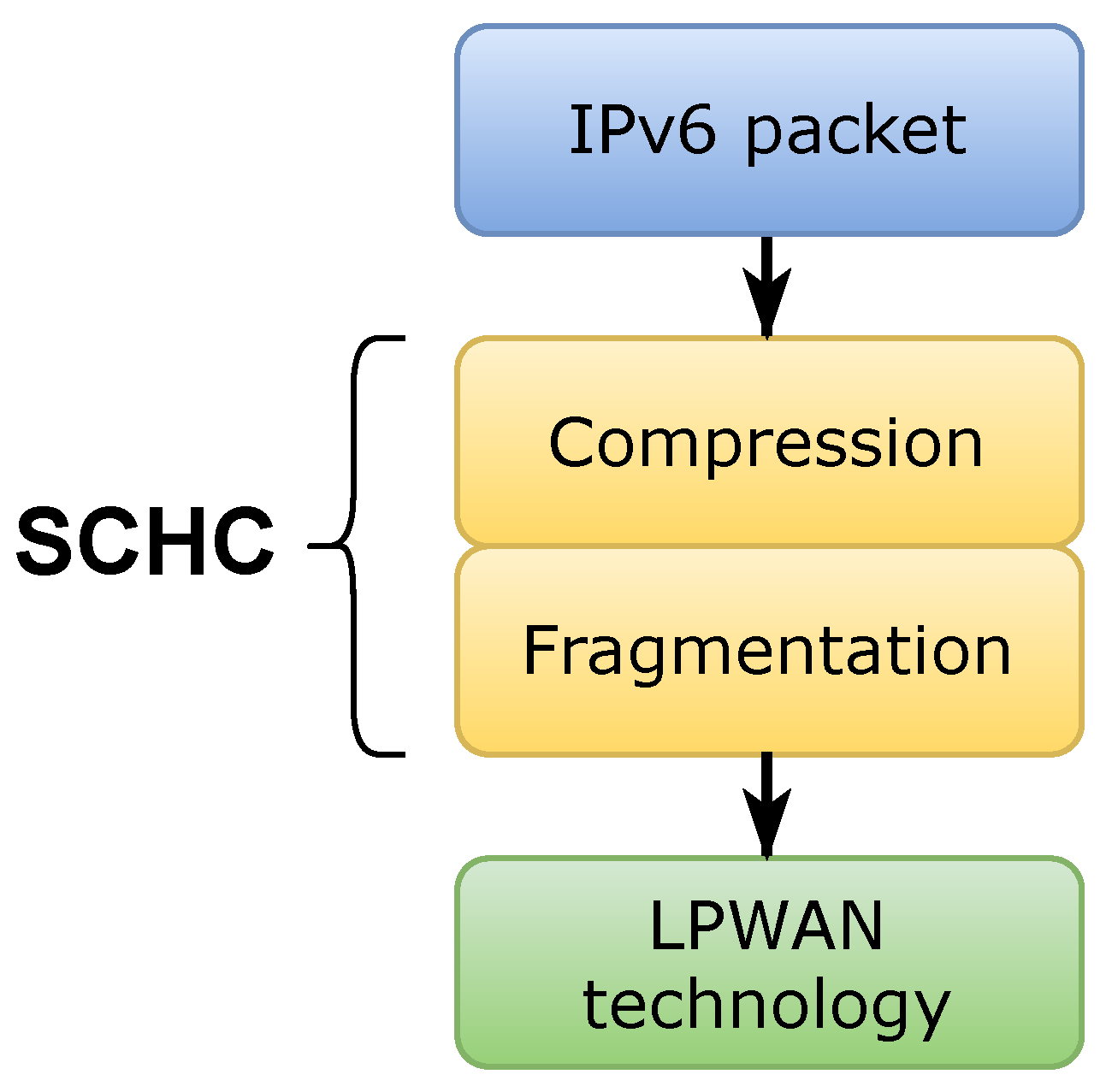
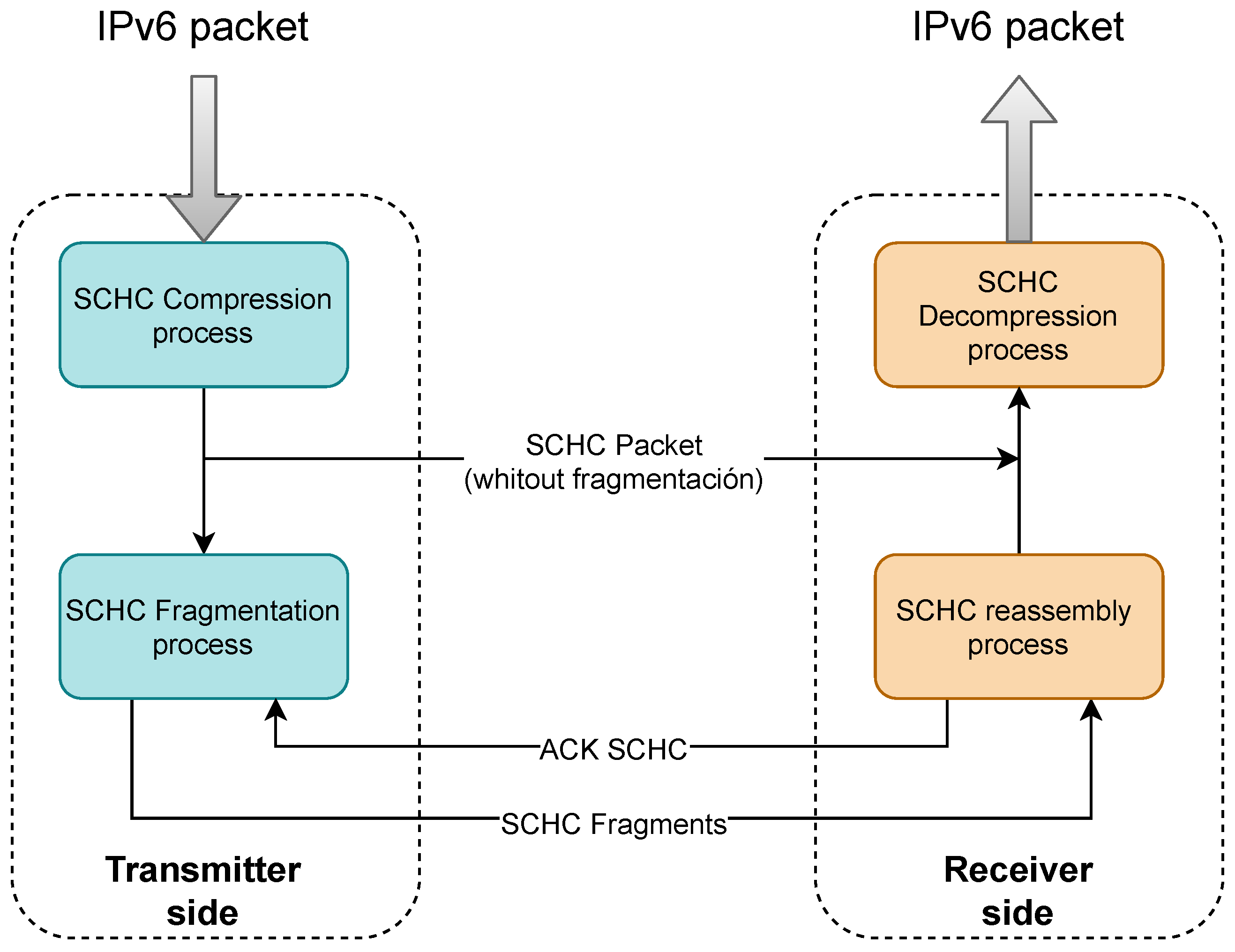

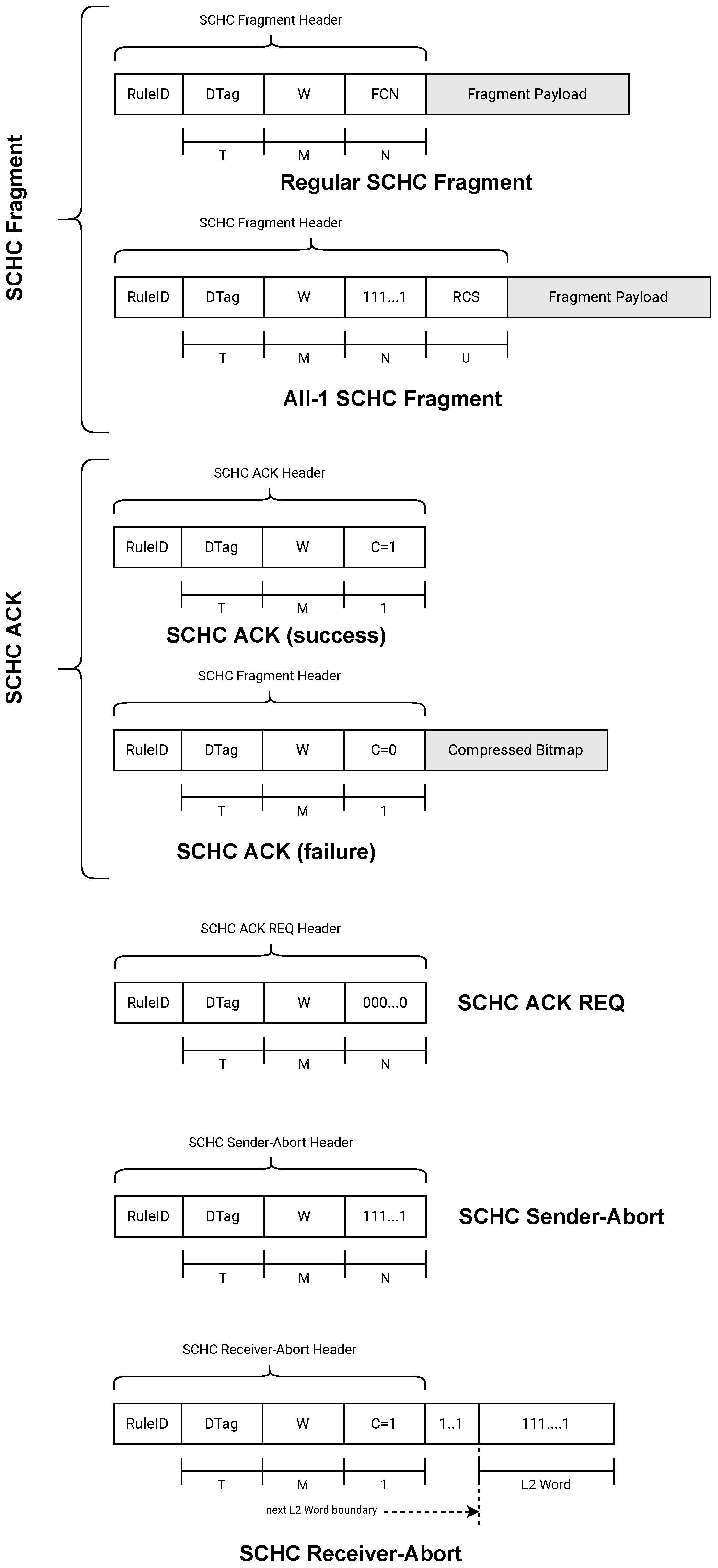
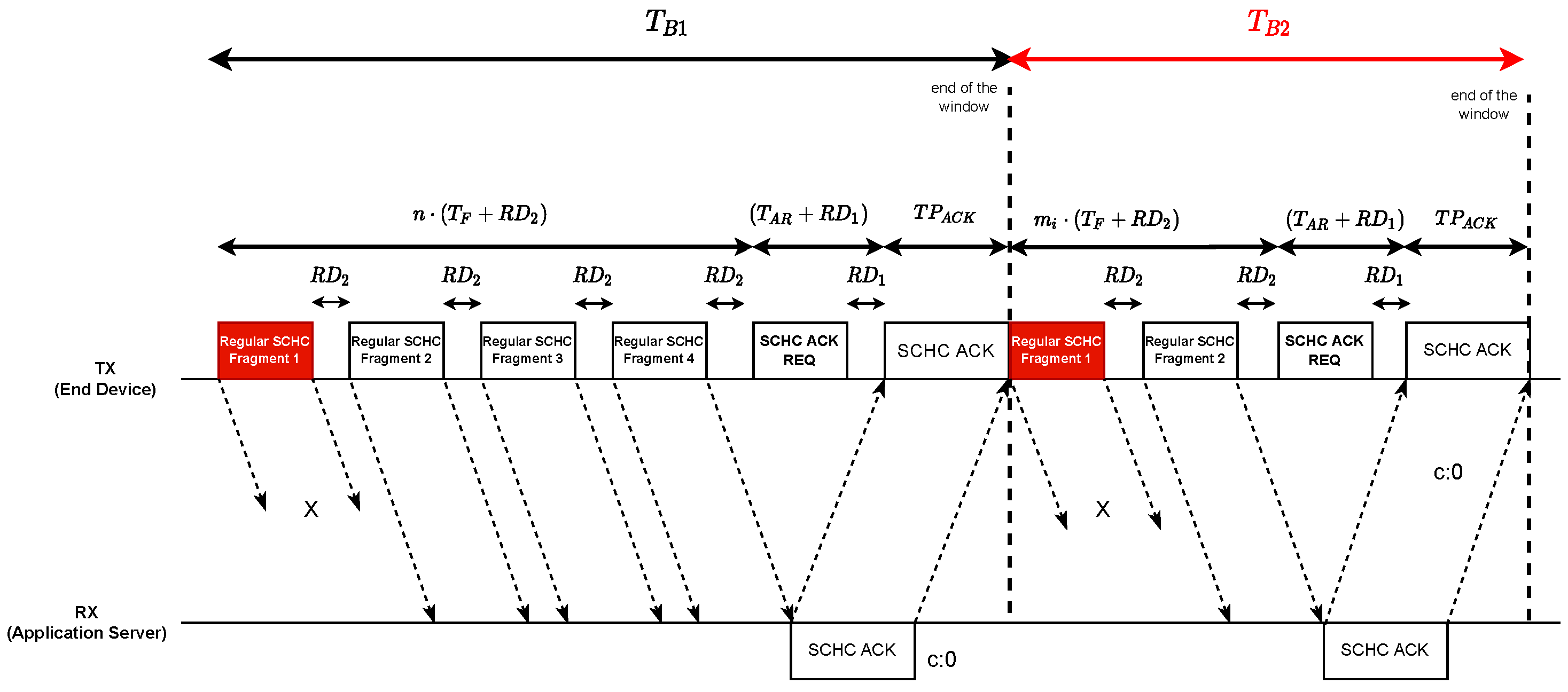

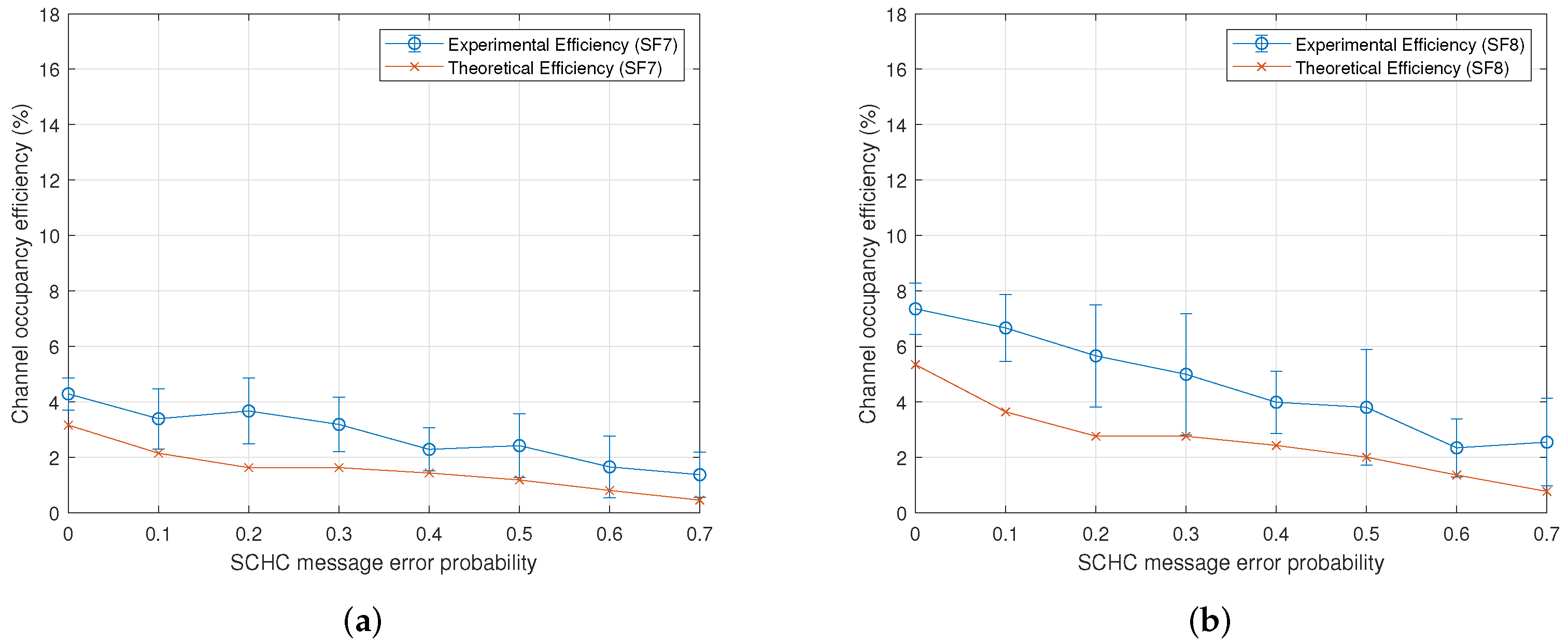
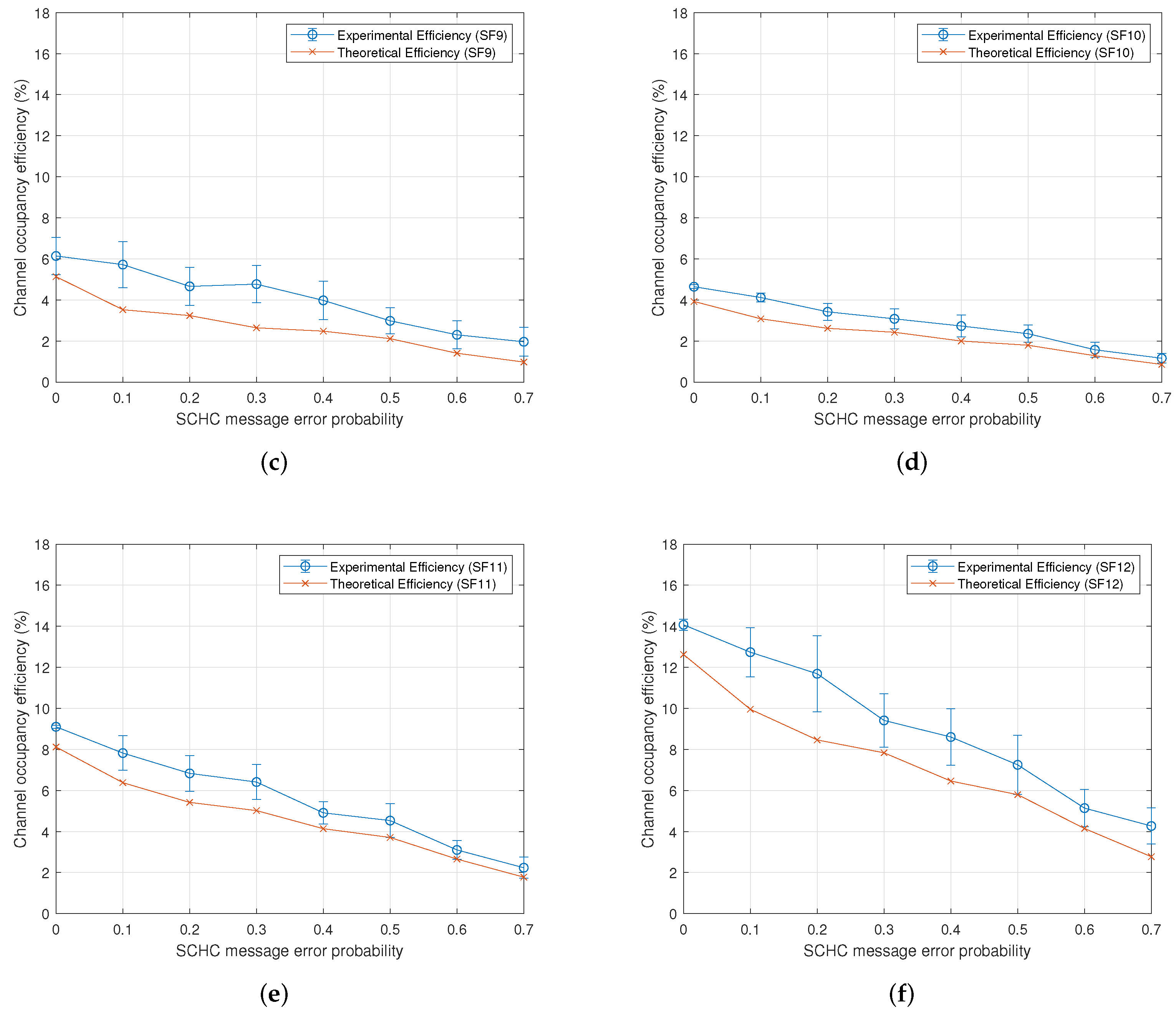
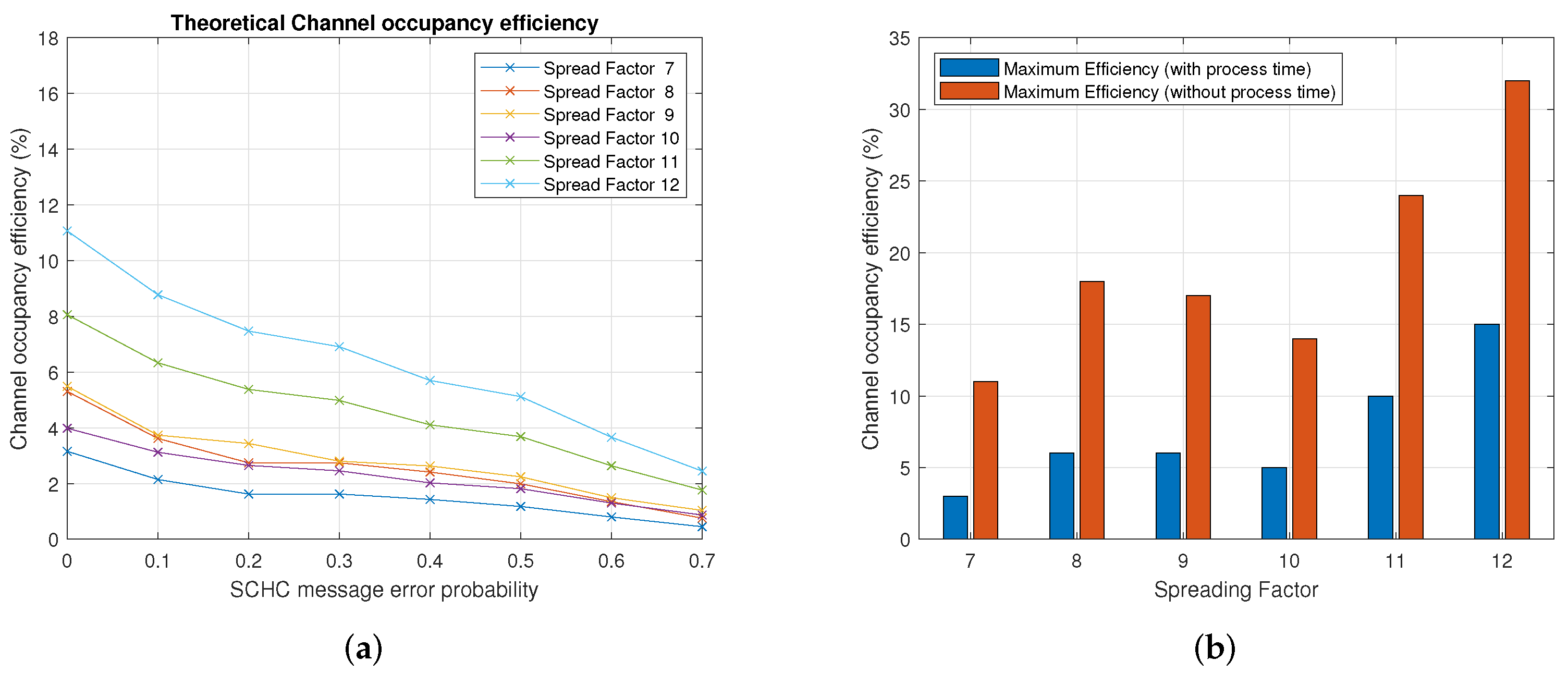
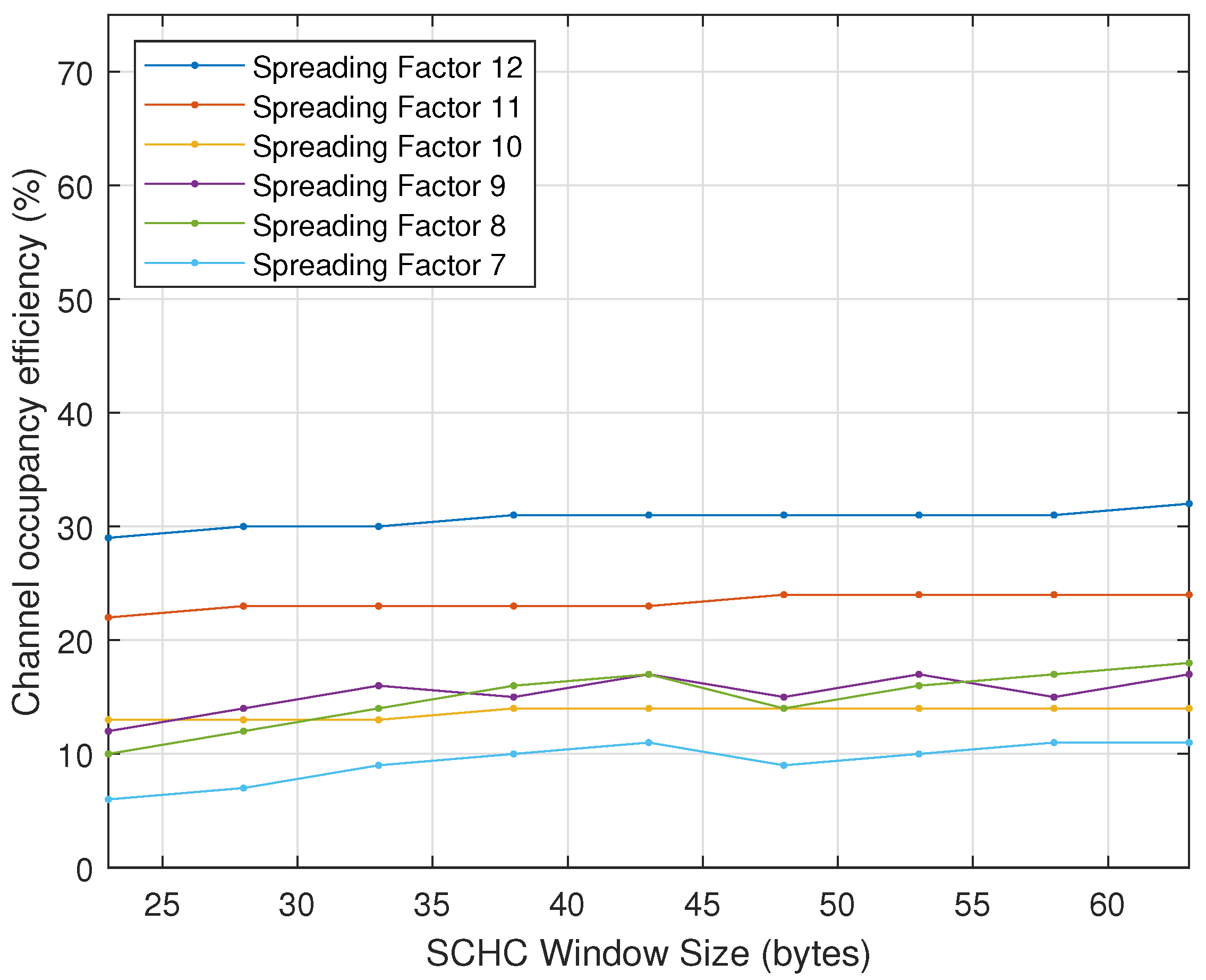
| Publication | Technology | Type of Model | Metric |
|---|---|---|---|
| [3] | Sigfox | Theoretical Experimental | * Transmission duration of a packet * Uplink messages exchanged * Downlink messages exchanged * Energy performance |
| [4] | Sigfox | Theoretical Experimental | * Packet transfer times * Number of uplink messages * Number of downlink messages |
| [5] | LoRaWAN | Experimental | * Latency * Delivery ratio * Overhead in end node resources * Useful payload sent per fragment |
| [6] | Sigfox LoRaWAN | Theoretical | * ACK traffic * Quality of the radio link * SCHC F/R parameters |
| [7] | LoRaWAN | Simulation | * Total Channel Occupancy * Goodput of SCHC layer * Total Delay of SCHC layer |
| Retransmission Window | |
|---|---|
| 1st window | |
| 2nd window | |
| 3rd window | |
| 4th window | |
| : | : |
| rth window |
| Parameter | Value |
|---|---|
| Data Rate | 0, 1, 2, 3, 4, 5 |
| LoRaWAN Frequency Band | AU915 |
| SCHC Packet Size | 892 bytes |
| SCHC Tile Size | 10 bytes |
| SCHC Fragment Processing Time () | DR5: 5223.6 [ms] DR4: 5300.8 [ms] DR3: 4661.7 [ms] DR2: 5101.6 [ms] DR1: 5285.2 [ms] DR0: 6634.2 [ms] |
| SCHC Ack Req Processing Time () | DR5: 5053.7 [ms] DR4: 5053.7 [ms] DR3: 4661.7 [ms] DR2: 5101.6 [ms] DR1: 5285.2 [ms] DR0: 6634.2 [ms] |
| Data Rate | SF | Maximum Payload Size (Bytes) | Physical Bit Rate (Bps) | n° of Tiles in a SCHC Fragment (Full Payload) | n° of SCHC Fragment (Full Payload) | n° of Remaining Tiles |
|---|---|---|---|---|---|---|
| 0 | 12 | 51 | 250 | 5 | 12 | 3 |
| 1 | 11 | 51 | 440 | 5 | 12 | 3 |
| 2 | 10 | 51 | 980 | 5 | 12 | 3 |
| 3 | 9 | 115 | 1760 | 11 | 5 | 8 |
| 4 | 8 | 222 | 3125 | 22 | 2 | 19 |
| 5 | 7 | 222 | 5470 | 22 | 2 | 19 |
| Data Rate | SF | SCHC Message Time | ||
|---|---|---|---|---|
| SCHC Fragment (Full Size) [ms] | SCHC Fragment (Not Full Size) [ms] | SCHC ACK REQ [ms] | ||
| 0 | 12 | 9793.5 | 9138.1 | 7155.1 |
| 1 | 11 | 8560.6 | 8151 | 6659.5 |
| 2 | 10 | 7698.4 | 7534.5 | 6288.8 |
| 3 | 9 | 7656.4 | 7533.5 | 6164.9 |
| 4 | 8 | 7645.6 | 7574 | 6082.4 |
| 5 | 7 | 7368.9 | 7322.8 | 6046.3 |
| Data Rate | SF | Maximum Payload Size (Bytes) | Physical Bit Rate (Bps) | Total ToA (without Process Time) [ms] | Maximum Efficiency (without Process Time) |
|---|---|---|---|---|---|
| 0 | 12 | 51 | 250 | 66,970 | 32% |
| 1 | 11 | 51 | 440 | 50,197 | 24% |
| 2 | 10 | 51 | 980 | 38,493 | 14% |
| 3 | 9 | 115 | 1760 | 19,125 | 17% |
| 4 | 8 | 222 | 3125 | 11,030 | 18% |
| 5 | 7 | 222 | 5470 | 10,153 | 11% |
| Data Rate | SF | Maximum Payload Size (Bytes) | Physical Bit Rate (Bps) | Total ToA (with Process Time) [ms] | Maximum Efficiency (with Process Time) |
|---|---|---|---|---|---|
| 0 | 12 | 51 | 250 | 141,970 | 15% |
| 1 | 11 | 51 | 440 | 125,197 | 10% |
| 2 | 10 | 51 | 980 | 113,493 | 5% |
| 3 | 9 | 115 | 1760 | 59,125 | 6% |
| 4 | 8 | 222 | 3125 | 36,030 | 6% |
| 5 | 7 | 222 | 5470 | 35,153 | 3% |
Publisher’s Note: MDPI stays neutral with regard to jurisdictional claims in published maps and institutional affiliations. |
© 2022 by the authors. Licensee MDPI, Basel, Switzerland. This article is an open access article distributed under the terms and conditions of the Creative Commons Attribution (CC BY) license (https://creativecommons.org/licenses/by/4.0/).
Share and Cite
Muñoz, R.; Saez Hidalgo, J.; Canales, F.; Dujovne, D.; Céspedes, S. SCHC over LoRaWAN Efficiency: Evaluation and Experimental Performance of Packet Fragmentation. Sensors 2022, 22, 1531. https://doi.org/10.3390/s22041531
Muñoz R, Saez Hidalgo J, Canales F, Dujovne D, Céspedes S. SCHC over LoRaWAN Efficiency: Evaluation and Experimental Performance of Packet Fragmentation. Sensors. 2022; 22(4):1531. https://doi.org/10.3390/s22041531
Chicago/Turabian StyleMuñoz, Rodrigo, Juan Saez Hidalgo, Felipe Canales, Diego Dujovne, and Sandra Céspedes. 2022. "SCHC over LoRaWAN Efficiency: Evaluation and Experimental Performance of Packet Fragmentation" Sensors 22, no. 4: 1531. https://doi.org/10.3390/s22041531
APA StyleMuñoz, R., Saez Hidalgo, J., Canales, F., Dujovne, D., & Céspedes, S. (2022). SCHC over LoRaWAN Efficiency: Evaluation and Experimental Performance of Packet Fragmentation. Sensors, 22(4), 1531. https://doi.org/10.3390/s22041531






